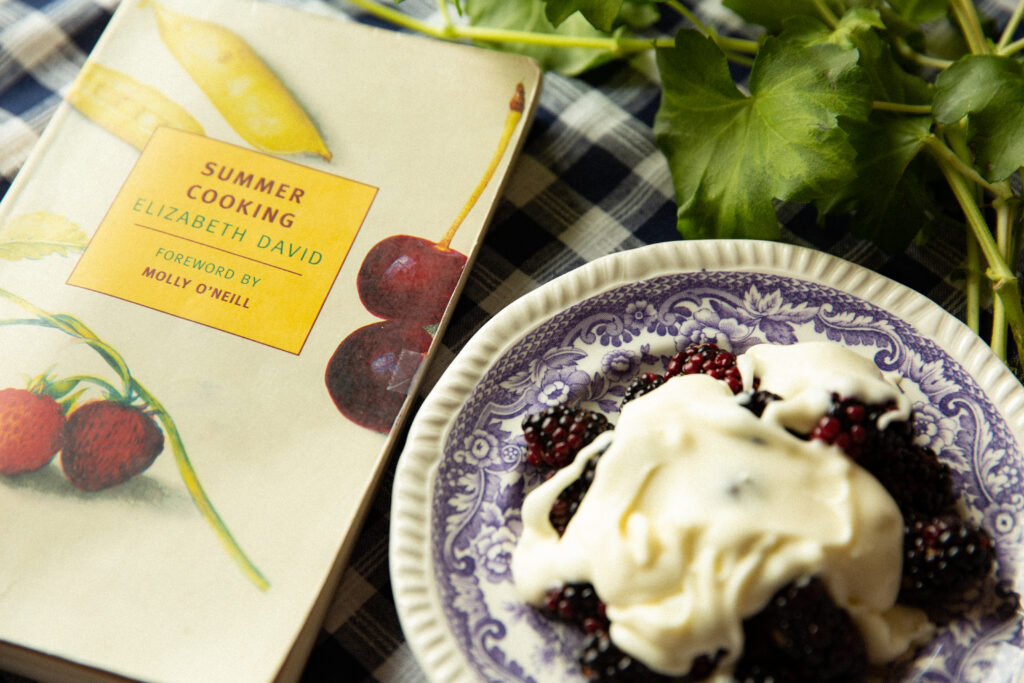
All photographs by Erica MacLean.
Elizabeth David considered herself “not a writer really you know, but only a self-made one”—primarily a cook. And she wasn’t a typical writer, even within her chosen genre of food writing. David abhorred the arty and artificial, kept her private life to herself, and made concessions to her audience only when it suited her values. Her voice, especially in her journalism, is acerbic—she was a woman who liked to eat well, and didn’t care what you thought of that. And yet she has been England’s most influential food writer since the peak of her career in the fifties, and she remains a household name in the UK. Her groundbreaking works, A Book of Mediterranean Food, French Country Cooking, and simply Italian Food, all published just after World War II, introduced the English to those cuisines. And her prose has the kind of precision and shimmering energy that makes one want to cook. I recently read the NYRB Classics edition of David’s Summer Cooking. I wanted to cook from David, and to understand the secret of her lasting appeal.
Summer Cooking is considered David’s most casual, personal, and playful work. It was written after the intense, yearslong labor of Italian Food and contains many of her perennial themes: fresh, seasonal ingredients, bright flavor, and simplicity. In the postwar England in which she launched her career, food was still rationed. People rarely saw meat and couldn’t get eggs or cream. Cans, powders, and substitutes were common. It was neither practical nor socially acceptable to be interested in what you ate. David drew on her experiences traveling and living abroad during the war, in France, Greece, and Egypt, where even basic meals were flavorful and fresh, to effect a massive shift in this thinking. In Greece, Artemis Cooper writes, David lived on “bread, olive oil, olives, salt fish, hard white cheese, dried figs, tomato paste, rice, dried beans, sugar, coffee and wine” and knew their intense joys. In Summer Cooking she applied the lessons she’d learned abroad to what was available in the English countryside, during its brief, wonderful production of “new peas,” “fresh little carrots,” “delicate courgettes,” “fresh green chives, chervil, tarragon, parsley,” “purple sprouting broccoli,” “tender little string beans,” crabs, trout, Cornish lobsters, damson plums, blackberries, gooseberries, and more.
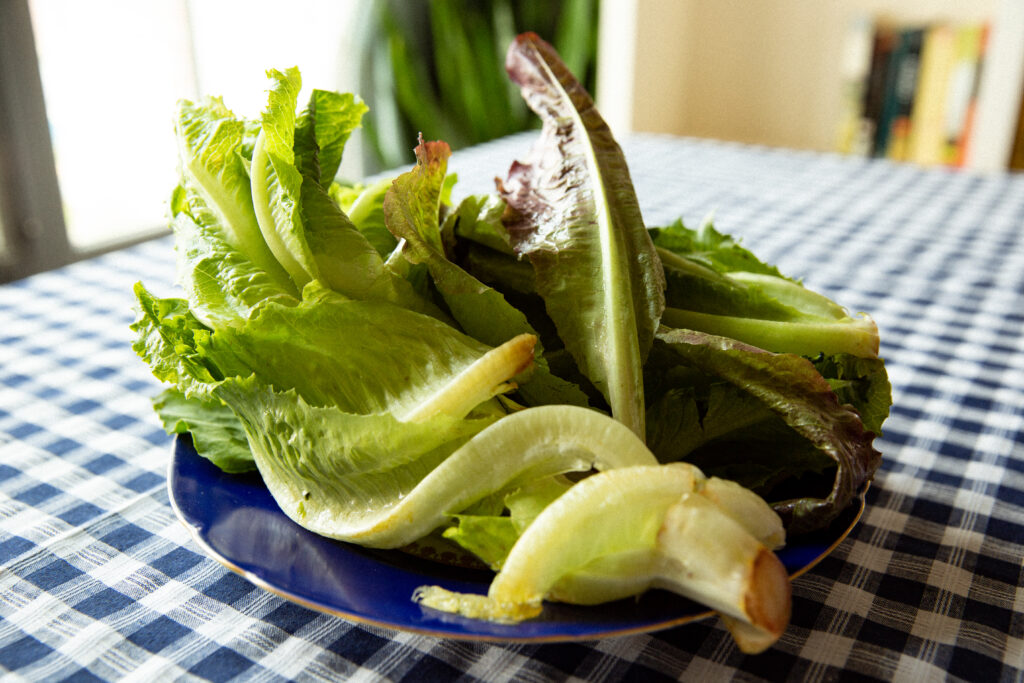
Much of David’s genius was in knowing when to stop. The best ingredients need little enhancement.
I decided to make a picnic-themed David menu from such seasonal farmer’s-market ingredients. Summer Cooking’s last chapter is devoted to picnics, which David loved, and it represents her work at its most discursive and delightful. She thought picnics could be accomplished two ways—by loading up at the market and having something impromptu, especially on vacation somewhere markets are good, or by bringing food cooked at home. A picnic combines David’s love of food with her ethos of the casual and situational, though her idea of casual was somewhat different from what ours might be today: when possible, she recommends an old-fashioned Edwardian picnic hamper stocked with real plates and cutlery. (She was writing against a backdrop of stuffy picnics that might be carried and plated by servants or involve an advance visit to the picnic spot to bury the champagne.) The chapter suggests various sandwiches, including smoked trout, and concludes with a smattering of quotations from literary texts and other historical sources, which always served as rich inspiration for David. One passage, written by a Col. Kenney Herbert in 1885, recounts a meal he enjoyed on “long days out surveying” for his garrison, of “a small foul, boned and rolled, with a block of tongue and some forcemeat introduced to the center,” which David says makes a great lunch on the go.
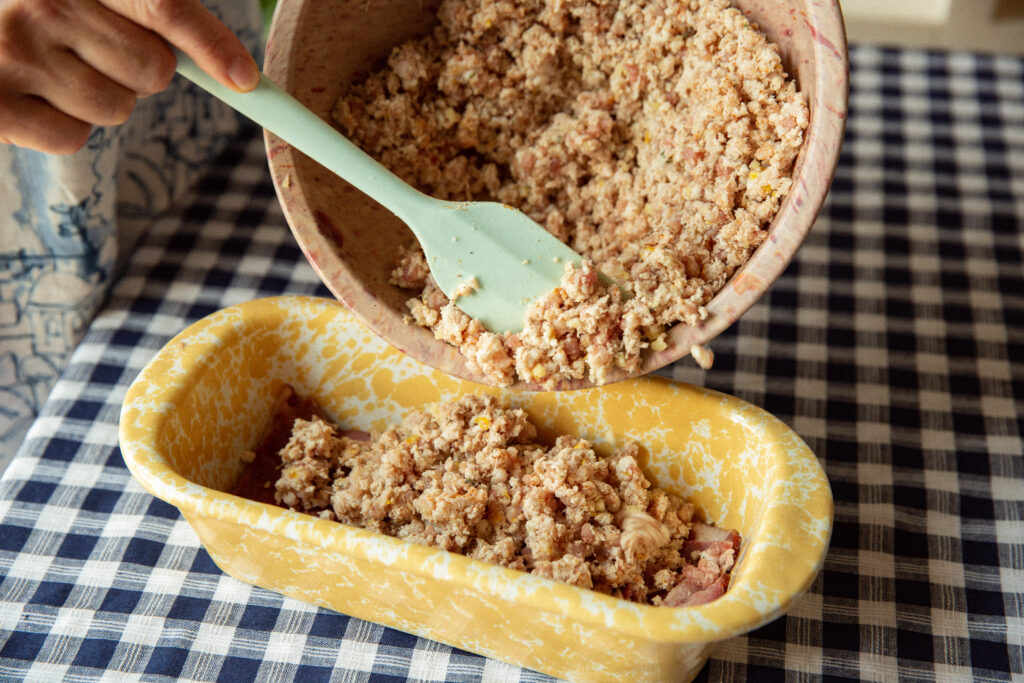
“Rabbits and pigeons are not exactly party food,” David warns, but “make first class terrines and pâtés.”
I was going to enjoy my David-inflected picnic with Kassia Oset and Dylan Cuellar, who had recently read Summer Cooking as part of their quest to read through the entire NYRB Classics backlist for their podcast, Unburied Books. Oset and Cuellar had recently relocated to New York City from Albuquerque, New Mexico, and they came with me to the Union Square Greenmarket for the fresh ingredients for our picnic. We began with those for the recipe that sets the tone for Summer Cooking, titled “A Summer Hors d’Oeuvre.” The recipe is not a recipe at all but a suggestion to get market ingredients such as “long, red radishes” and “raw, round, small, whole tomatoes,” and serve them in little dishes with bread, olive oil, salt, and butter. We’d follow this course with a cool pale green and white lettuce-wedge salad of utmost simplicity and a cold smoked-trout soup. Aspics and terrines are prominent features of Summer Cooking, though the former might melt in the heat and so are not recommended for a picnic. We channeled the old-fashioned spirit of Col. Herbert and planned a rabbit terrine to be served in slices on sandwiches (though we ran out of chilling time and later ate it plain). For dessert, we were intrigued by the focus on cream cheese in the section of the book devoted to sweets. It wasn’t clear precisely what cheese David meant, since she specified Isigny or Chambourcy, neither of which was available in supermarkets nor defined on the internet, but a recipe using one to make a “geranium cream” served with blackberries sounded too tempting to pass up.
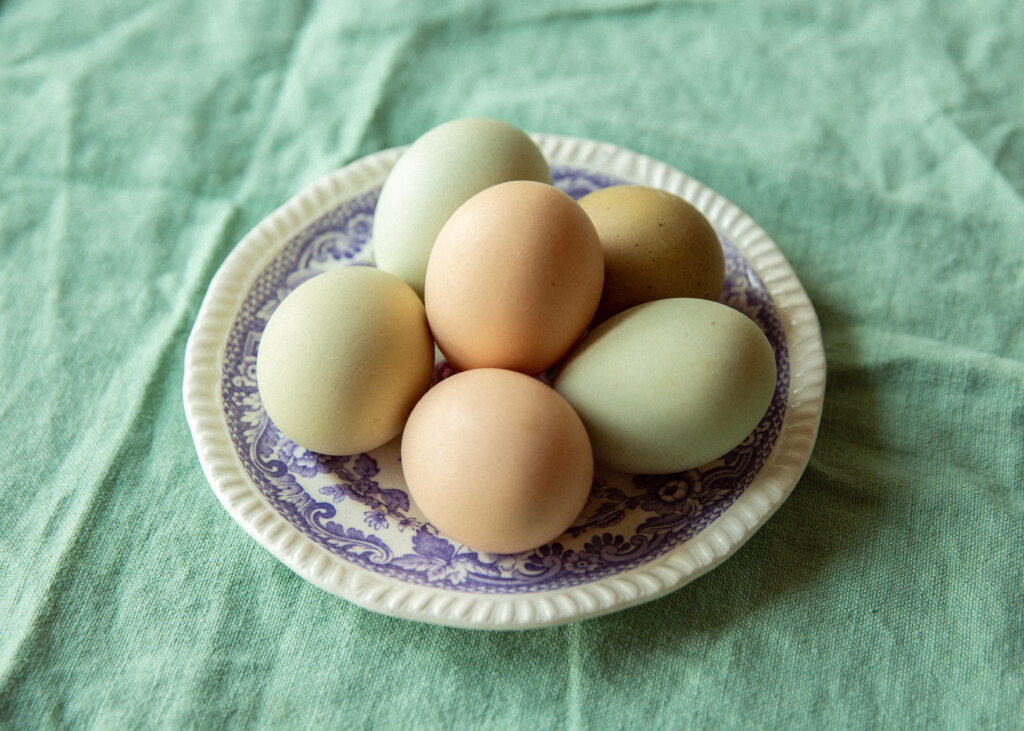
Eggs, to hard-boil and garnish with parsley. “Not very original, perhaps,” David writes, “but how often does one meet with a really fresh and unmessed hors d’oeuvre?”
Most people involved in contemporary food culture agree that casual, fresh, and seasonal is a wonderful way to eat. The items on our list for a David picnic sounded to me like they could be found on many a contemporary restaurant menu. I thought of Cafe Mutton in Hudson, New York, as an example: the exact kind of place that would have something similar to a small foul, boned and rolled and stuffed with forcemeat and tongue. (Forcemeat is any kind of meat or fish ground and mixed with fats and seasonings.) David was a pioneer, but much of what she championed has become mainstream or even cliché. Yet to me David’s writing has a quality that resists this tiredness—an ability to identify the important part and strip away the rest. Her mission is the simple but vital one of suggesting we eat this wonderful food because of its essential goodness, and explaining how.
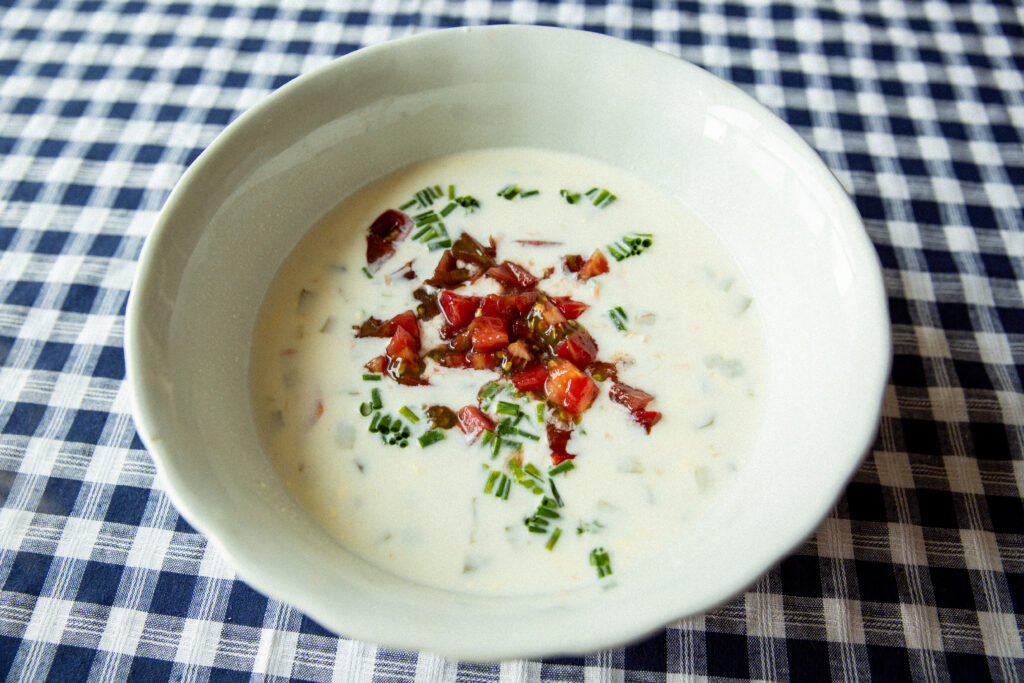
Soups, David writes, should be “very good, attractive, light, well seasoned, promising even more delicious things to come.”
David was prickly and notoriously private, despite being a star of English arts and letters. Much of her camouflage was protective. As the truth emerges in her authorized biography Writing at the Kitchen Table, by Artemis Cooper, she’d endured the lonely, nursery-isolated childhood of the English upper classes (and ate the execrable stewed prunes and mushes served therein, to her lasting horror). At the outbreak of World War II she was twenty-six years old and adrift, sailing the Mediterranean with a lover, a working-class writer of whom her family did not approve. The two were arrested, mistaken for spies in Italy, spent a hungry and terrifying stint in prison, and eventually washed up in the Greek islands, safe but dependent on local peasant foodstuff. Later during the war, she married a man she didn’t love “for the Mrs.” The two eventually separated, but David hid behind the appellation in writing for all her life. As it emerges, David knew hunger both in the sense of food insecurity and in the much greater one of emotional privation, and this knowledge informed her work. Cooper recounts that in her successful but sad late-middle age, after the end of her life’s great love affair, she went to visit a friend in Valencia, the photographer Anthony Denney, and found some renewed will to live from a nameless dish that the locals called simply ensalada. “The enormous ridged tomatoes were cored with a little sharp knife, cut round roughly into sections, thrown into a shallow bowl, mixed with thickly sliced raw onions, mild and very sweet. Salt, a sprinkling of olive oil and wine vinegar were the only seasonings,” David writes in a piece from that period.
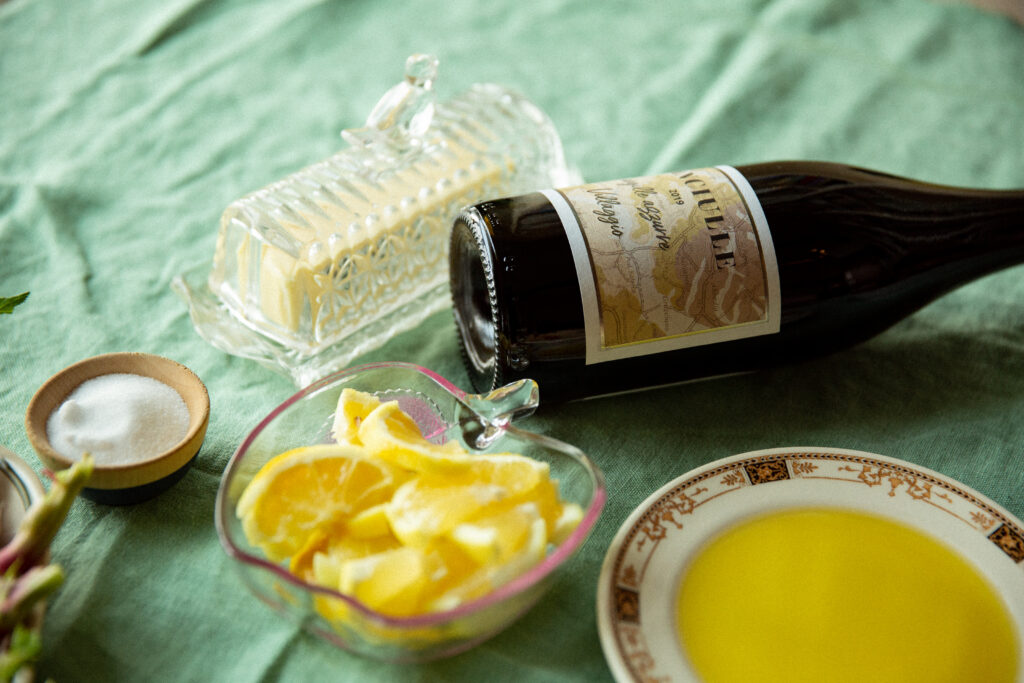
David’s school of picnicking called for fresh market ingredients, “cheap red wine,” and “stopping now and again for a drink” on the way to the destination.
David’s talents, plus the keenness of vision inspired by her experiences of privation, have resulted in a uniquely powerful and lasting body of work that’s distinct from the contemporary food writing it might seem to thematically resemble. When Oset and Cuellar and I tried her food, we also found it to be different from what we’d expected, and different from food we’d had before. First, David’s promise of simplicity in putting the dishes together was borne out. There were small mysteries. She did not explain the answers to questions that were assumed knowledge, such as why the smoked fish for our soup needed to be cooked in milk. (Plus: How much fish, and for how long?) But even so, the dishes came together quickly. Even the intimidating-sounding rabbit terrine was a fairly hands-off matter of simmering the rabbit, pulling the meat, and putting it through a grinder with an equal amount of pork belly and some spices. Most of the dish’s time was in baking and chilling. The three of us were at the table, ready to dine, before we knew it. We did not picnic outdoors, but we discussed the plusses and minutes of the picnicking lifestyle, especially in summer—Oset and Cuellar had recently brought sandwiches to Valles Caldera National Preserve in New Mexico; our photographer for the evening, Erica MacLean, had tried to go to a park in Brooklyn, but got too hot and ended up drinking raspberry lemonade and watching Call Me By Your Name at home.
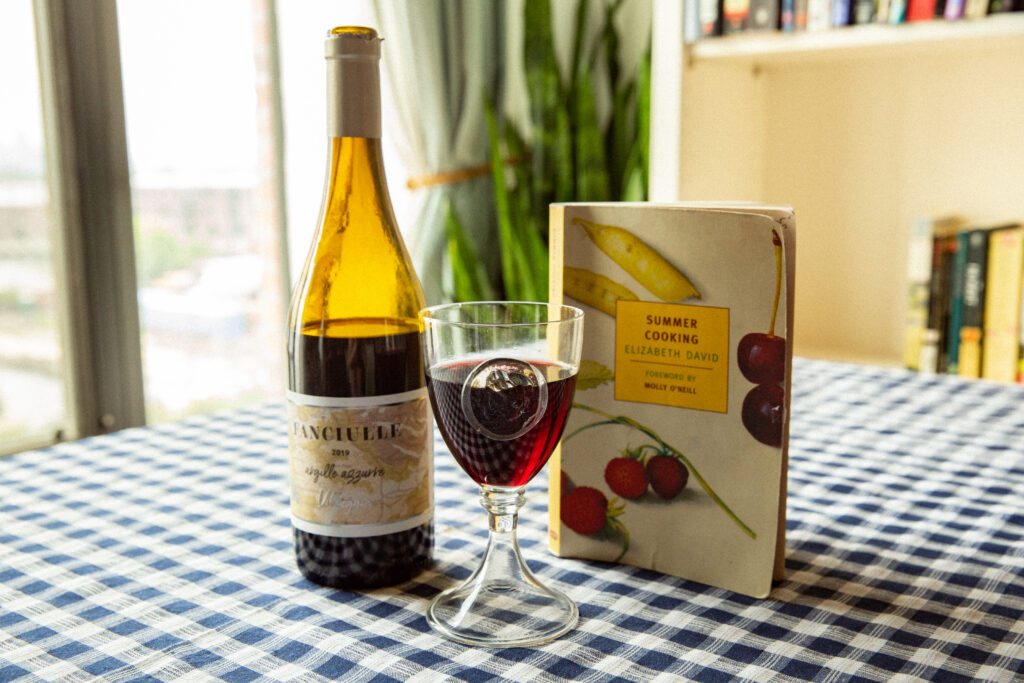
For picnics, David recommends a “stout” red wine like a Chianti. This Fanciulle wine made from the same grape (Sangiovese) in the same region (Tuscany) tasted intensely of summer fruit.
Even indoors, our food had a crispness, cleanness, and lightness we’d rarely encountered before. We buttered our radishes and dusted them with salt, popped sweet little cherry tomatoes into our mouths, and dipped bread in olive oil. The minimalist salad, served unsalted and decorated only with a creamy white dressing and chopped egg white, was particularly delicate and unusual. The cold fish soup tasted like a soup version of a bagel with lox in the best possible way. Our terrine was well seasoned, and rich but light. David was a wine enthusiast (rough or fine, she drank it all)—and one collection of her journalism in publications including Vogue, Punch, The Spectator and the Sunday Times is even called An Omelette and a Glass of Wine. For summer dining she often recommended “cheap,” “coarse,” “stout” stuff, and Chianti in particular. Sangiovese, the grape Chianti is made from, makes for a rich, full-bodied red wine that tastes intensely of cherries, and didn’t sound like a natural match for raw vegetables and a hot day. But I followed David’s advice, and my spirits collaborator, Hank Zona, recommended a bottle of Sangiovese from the small-batch Tuscan producer Fanciulle—not a Chianti but from the same grape. The wine, a 2019 Villaggio, was neither cheap nor coarse, but it was made from grapes from a single vineyard and tasted like the hyperlocal equivalent of David’s best meals. It went well with the earthy bread and the smoky flavor of the rabbit terrine, and tasted intensely of cherries, blackberries, and spice.
My favorite element of the meal was the subtle geranium cream with blackberries. For that exquisitely simple dish, you steep geranium leaves in sweetened cream overnight, then mix in the cream cheese and dollop the combined mixture on a plate of blackberries as a topping. I tried both mascarpone and ordinary Philadelphia cream cheese in the recipe and preferred the latter, which had just enough sour tang to cut the sweetness of the cream. The dish had five ingredients, nothing more, nothing less, and was emblematic of David’s simplicity, restraint, and unerring taste. The geranium leaves added the faintest and most delicate perfume—a source of difference that was difficult to pinpoint, but tasted like summer.
A Summer Hors D’Oeuvre
Radishes, cleaned “but with a little of the green leaves left on”
Mixed green and black olives
Cherry tomatoes
Hard boiled eggs (“not too hard”-boiled)
Parsley
Pepper and salt, in mills
Lemons
Olive oil
Butter
Fresh bread
Place the radishes, olives, and cherry tomatoes in separate dishes. Cut the eggs lengthwise, garnish with parsley, and plate. Put these plates on the table with the pepper, salt, lemons (possibly cut into wedges), butter, and fresh bread. Directions elsewhere suggest that the bread be “cubed.” Allow guests to freely nosh while drinking wine.
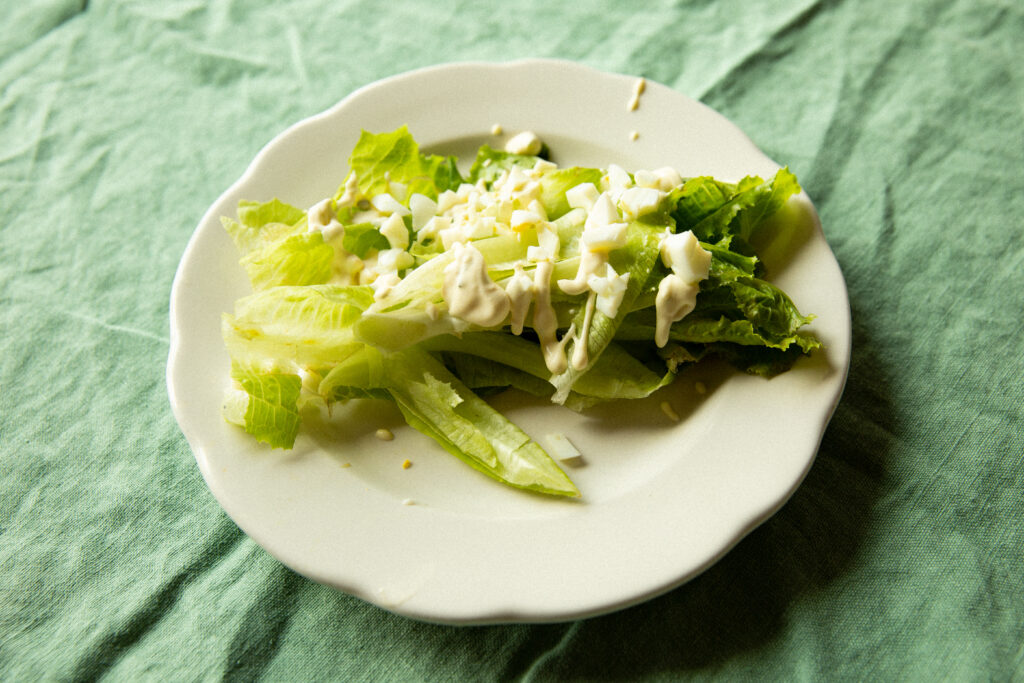
Laitue à la Creme
½ tsp mustard
1 tsp sugar
2 tsp tarragon vinegar
¼ clove garlic, pounded into a paste
1 hard-boiled egg, separated into yolk and white
Tarragon, to taste
Chives, to taste
Teacup’s worth fresh cream
Romaine lettuce hearts
Salt and pepper, to taste
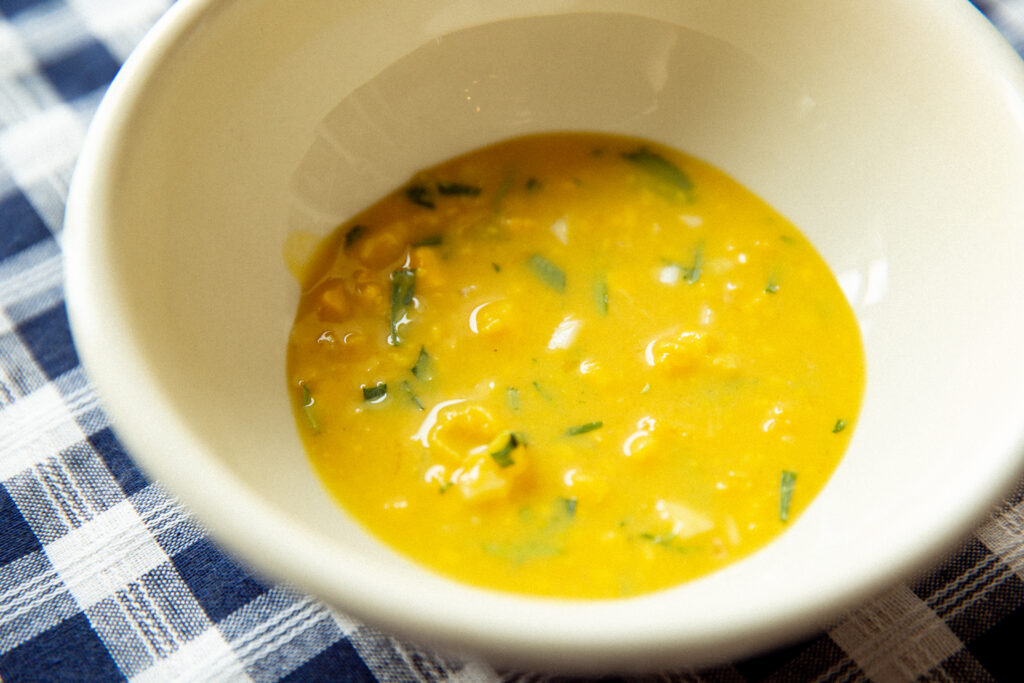
To make the dressing, mix together the mustard, sugar, vinegar, garlic, and cream. Chop the tarragon and garlic and mix them in to taste. Chill. Cut the lettuce into wedges. Just before serving, pour the dressing over the wedges and sprinkle over the chopped white of the egg. Season to taste.
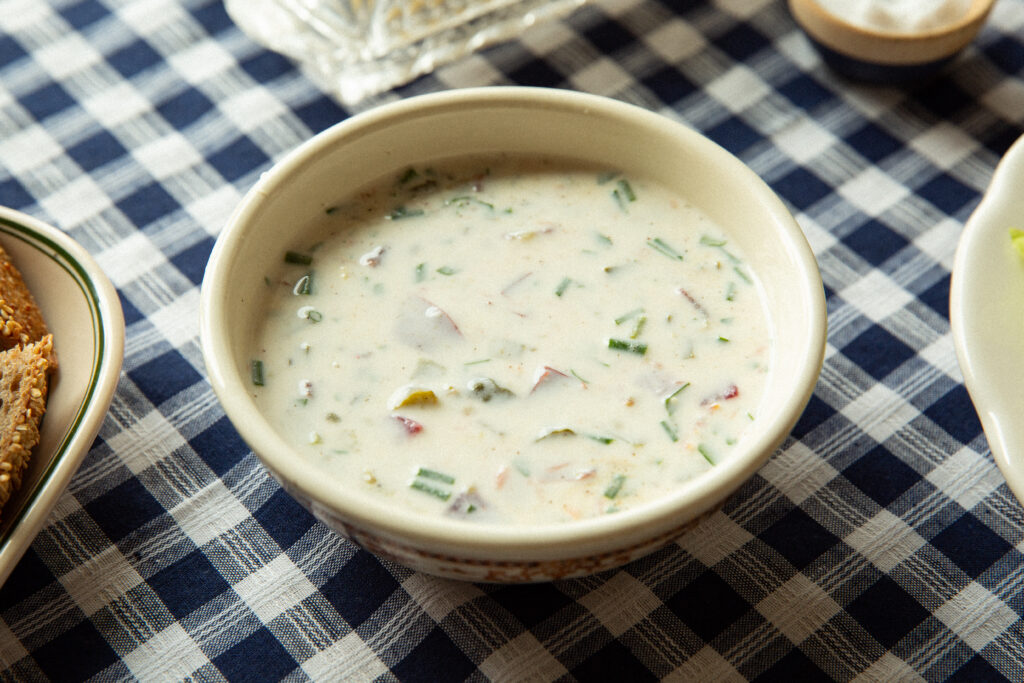
Iced Haddock Soup
David’s recipe calls for smoked haddock; I used smoked trout, which is more widely available.
¾ cup of smoked fish, haddock, or trout, divided
1 ¼ cup milk
1 cup yogurt
1/3 cup “cucumber in dill” (pickles, not sweetened), chopped
1 cup good tomato, chopped
Handful of parsley, chopped
2 small pickled onions, sliced
½ fresh cucumber, chopped
1 tbsp capers, chopped
1 tbsp chives, minced
Black pepper, to taste
Simmer half a cup of the fish in the milk for five minutes, then turn off the heat and leave to cool. Strain, then mix one cup of the milk together all the remaining ingredients. Season with pepper and add a few drops of the pickling liquid from the cucumbers. Chill and serve.
Terrine of Rabbit
1 lb rabbit pieces, skinned and cleaned
1 lb pork belly, diced
“A good sprinkling” fresh thyme
8 juniper berries, pounded
Zest of 1 lemon
3 cloves of garlic, roughly chopped
Salt
Pepper
Mace
2 tbsp brandy
¼ lb good-quality bacon in strips
3 bay leaves
Pork fat to seal
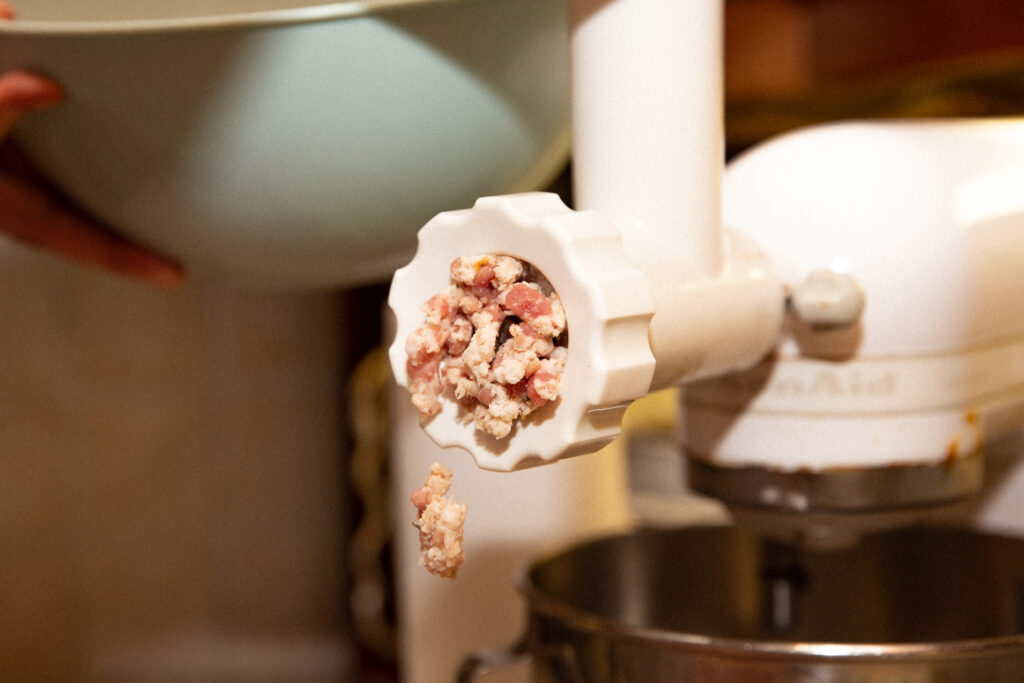
Preheat the oven to 300 degrees Fahrenheit.
Simmer the rabbit on the stove in a little water, about forty-five minutes, until the meat is cooked through and separates easily from the bone. Drain, reserving the stock for another usage, and let cool. Pull the meat from the bones. In a bowl, combine the rabbit, pork belly, thyme, juniper, lemon zest, and garlic, and put through a meat grinder. Season “fairly highly” with salt, pepper, and mace. Add brandy and stir.
Layer a loaf dish (or several small terrines, if you have them) with bacon. Add the meat mixture, pat down firmly and top with bay leaves and another layer of bacon. Bake for two and a half hours, covered. When finished, cool, cover the dish with tinfoil, place on top the heaviest weight you can devise, and refrigerate for twenty-four hours. The next day, the terrine can be sealed with pork fat, sliced, and served.
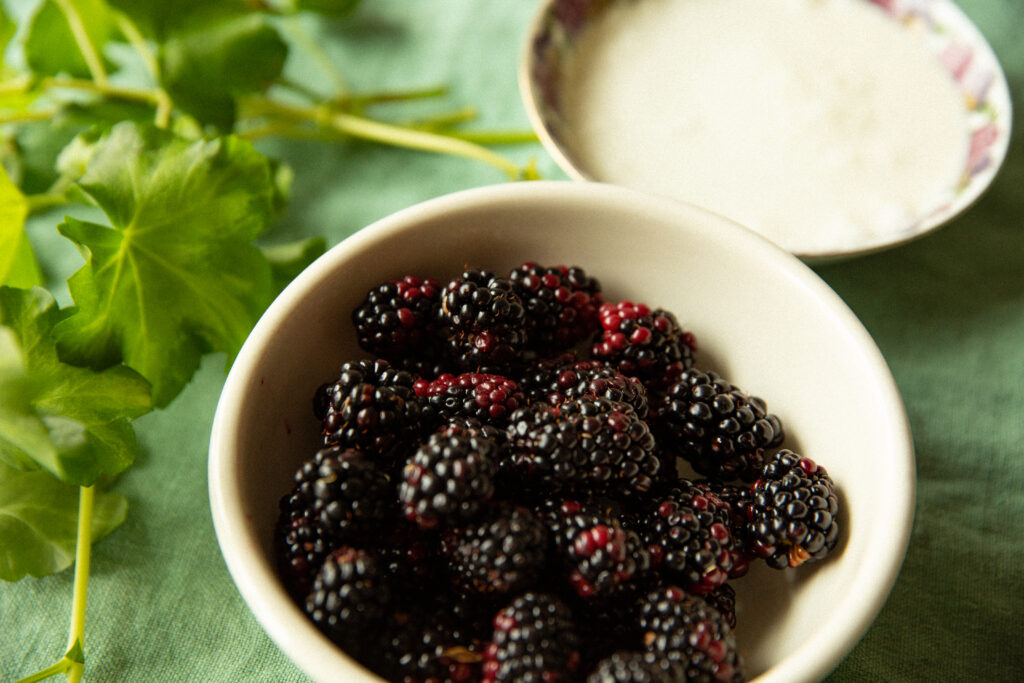
Geranium Cream
1 cup fresh cream
¼ cup sugar
2 large sweet-scented geranium leaves
4 oz cream cheese, room temperature
Blackberries
Put the cream into a saucepan, add the sugar and the geranium leaves, and steam gently, letting the cream get “thoroughly hot” but not bringing it to a boil. Cool and chill overnight. The next day, add the cream cheese and stir thoroughly to combine. Serve a dollop as a topping on a small dish of blackberries.
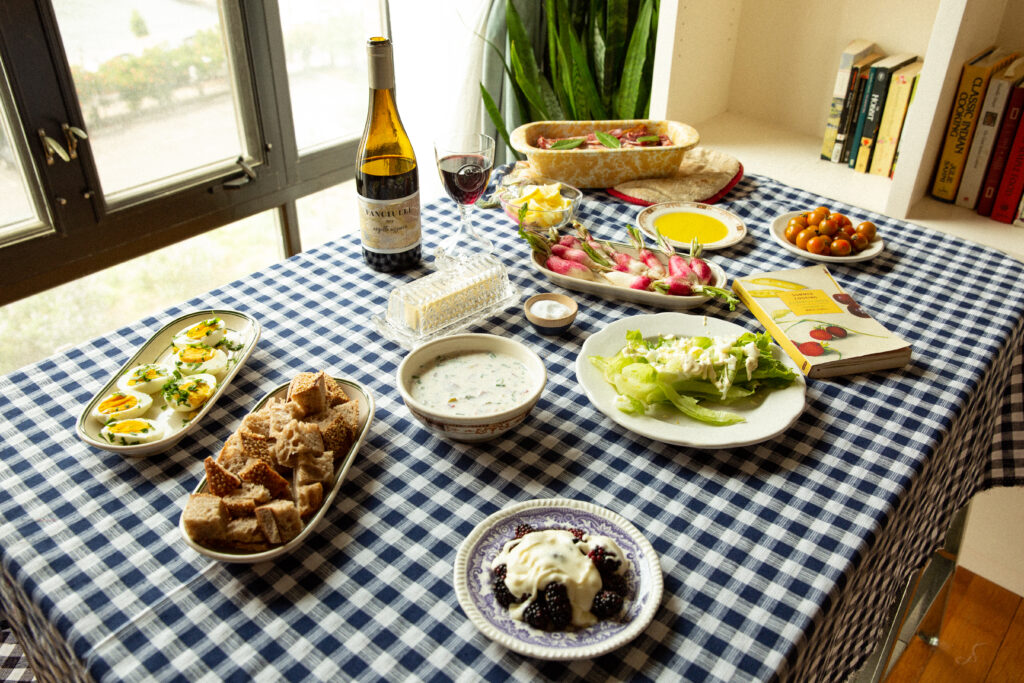
Valerie Stivers is a writer based in New York. Read earlier installments of Eat Your Words. She discusses Elizabeth David further on the Unburied Books podcast.
from The Paris Review https://ift.tt/LGlb3Ug
Comments
Post a Comment